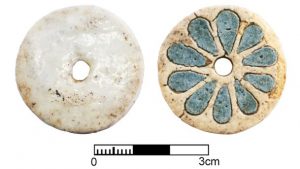Archaeologists excavating a Bronze Age city in Cyprus discovered a tomb containing a treasure of Egyptian scarabs, diadem, exotic luxuries and pearls and earrings set in gold. The site of Hala Sultan Tekke is dated to 1500 BC. The artefact attest to Cyprus’ importance as a commercial hub. The grave was a burial place for a local family and contained eight children and nine adults.

The burial was discovered due to prior geophysical survey with Ground Penetrating Radar (GPR) and was partially exposed due to erosion caused by farming. The surveying revealed almost 100 underground pits, some of which turned out to be wells, some offering pits and a grave.

Archaeologists from Gothenburg University have discovered one of the grandest graves from the Late Bronze Age ever found on the island of Cyprus. The burial contained numerous magnificently worked gold objects, including the diadem, pearls, earrings and scarabs, and the richly ornamented ceramic vessels, originating from various cultures. Other discoveries include gemstones and five cylinder seals, some produced locally and some possibly from Syria and Mesopotamia, and a bronze dagger and over 140 complete ceramic vessels. Other finds originated in Egypt. Two of the stone scarabs are gold-mounted and one features hieroglyphs spelling “men-kheper-re” next to an illustration of a pharaoh, referring to Thutmosis III (1479–1425 BC).

(after Haaretz)